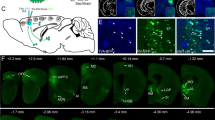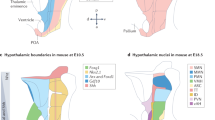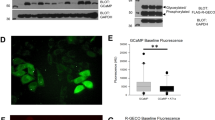Abstract
NEURONES in the supraoptic and paraventricular nuclei of the hypothalamus synthesise two peptide hormones, vasopressin and oxytocin. These hormones and their neurophysin ‘carrier’ proteins are stored in (and released from) nerve endings in the posterior lobe of the pituitary1–3. On the basis of extensive studies of the synthesis of vasopressin in vivo and in vitro, Sachs et al.4–8 have suggested that vasopressin and its associated neurophysin are synthesised as parts of a common precursor by a ribosomal mechanism. We have also presented evidence that the neurophysins are synthesised as parts of larger precursor molecules9,10. These 20,000 molecular weight precursors seem first to give rise to 17,000 molecular weight intermediates which, in turn, yield the 12,000 molecular weight neurophysins. The following data show that the putative neurophysin precursors and intermediates bind specifically to anti-rat neurophysin antiserum.
This is a preview of subscription content, access via your institution
Access options
Subscribe to this journal
Receive 51 print issues and online access
$199.00 per year
only $3.90 per issue
Buy this article
- Purchase on Springer Link
- Instant access to full article PDF
Prices may be subject to local taxes which are calculated during checkout
Similar content being viewed by others
References
Bargman, W. in Neurophypophysial Hormones and Similar Polypeptides (ed. Berde, B.) 1–39 (Springer, Berlin, 1968).
Heller, H. in Handbook of Physiology, section 7: Endocrinology, 4 (ed. Knobil, E. & Sawyer, W. H.) 103–117 (American Physiological Society, Washington, DC, 1974).
Sachs, H. J. Neurochem. 5, 297–303 (1960).
Sachs, H. & Takabatake, Y. Endocrinology 75, 943–948 (1964).
Sachs, H., Fawcett, P., Takabatake, Y. & Portanova, R. Recent Progr. Horm. Res. 25, 447–491 (1969).
Sachs, H., Pearson, D. & Nureddin, A. Ann. N.Y. Acad. Sci. 248, 36–45 (1975).
Takabatake, Y. & Sachs, H. Endocrinology, 75, 934–942 (1964).
Gainer, H., Sarne, Y. & Brownstein, M. J. Science 195, 1354–1356 (1977).
Gainer, H., Sarne, Y. & Brownstein, M. J. J. Cell Biol. 73, 366–381 (1977).
Palkovits, M. Brain Res. 59, 449–450 (1973).
O'Farrell, P. H. J. biol. Chem. 250, 4007–4021 (1975).
Self, S. M., Huellmantel, A. B., Platia, M. P., Haluszczak, C., & Robinson, A. G. Endocrinology 100, 1317–1326 (1977).
Brownstein, M. J. & Gainer, H. Proc. natn. Acad. Sci. U.S.A. (in press).
Mains, R. E. & Eipper, B. A. J. biol. Chem. 251, 4115–4120 (1976).
Author information
Authors and Affiliations
Rights and permissions
About this article
Cite this article
BROWNSTEIN, M., ROBINSON, A. & GAINER, H. Immunological identification of rat neurophysin precursors. Nature 269, 259–261 (1977). https://doi.org/10.1038/269259a0
Received:
Accepted:
Issue Date:
DOI: https://doi.org/10.1038/269259a0
This article is cited by
Comments
By submitting a comment you agree to abide by our Terms and Community Guidelines. If you find something abusive or that does not comply with our terms or guidelines please flag it as inappropriate.



